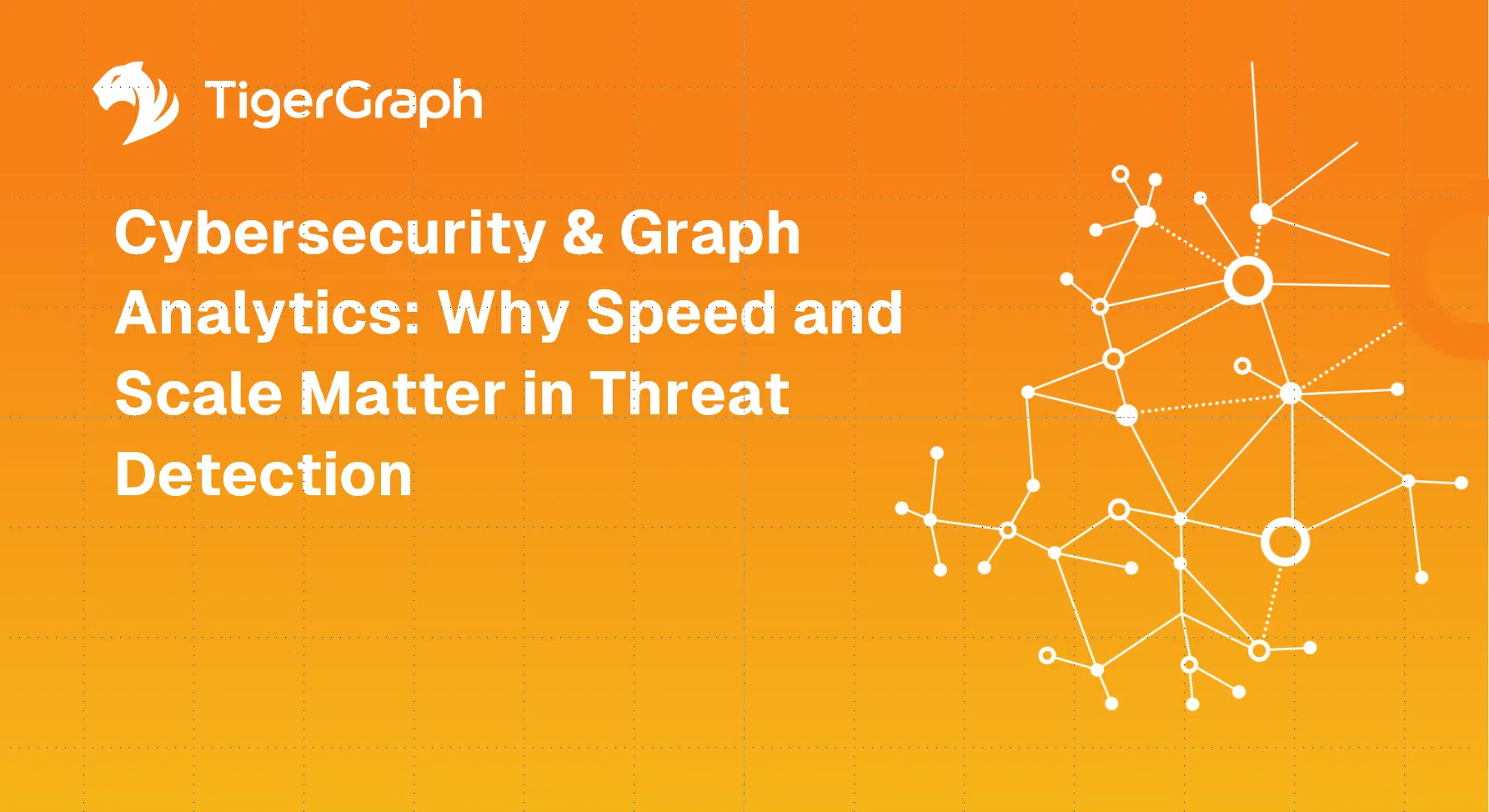Cybersecurity & Graph Analytics: Why Speed and Scale Matter in Threat Detection
Modern cybersecurity threats don’t happen in isolation—they unfold as chains of behavior across users, devices, and systems. One login anomaly means little, but a sequence of events—unusual access, lateral movement, privilege escalation—can signal an active breach.
The challenge is that most cybersecurity tools weren’t built to follow those chains in real-time. To detect threats as they happen, organizations need more than faster alerts. They need connectional awareness—and that’s where graph analytics changes the game.
When Google acquired Wiz for $32 billion, part of the appeal was Wiz’s use of graph modeling to map cloud assets and their security posture. This underscores how critical graph-based cybersecurity has become—and why enterprises need graph-native infrastructure like TigerGraph at the core.
The New Threat Landscape Is Connectional
Cyberattacks today don’t knock down the front door—they slip in through the side windows, one by one. These are no longer isolated incidents or simplistic hacks. Modern threats unfold as multi-stage, multi-vector campaigns that span users, devices, and systems—sometimes over hours, sometimes over weeks. And critically, they use credentials that appear legitimate, operating within what looks like normal behavior.
This new threat landscape is inherently connectional:
- It’s distributed, spanning cloud-native services, on-prem infrastructure, and hybrid architectures.
- It’s coordinated, involving actors who collaborate, hand off credentials, and execute stepwise attacks that avoid detection.
- It’s camouflaged, hiding in long chains of privilege escalation, lateral movement, and role misalignment.
Traditional security information and event management (SIEM) tools and rule-based detection engines can’t keep up. They analyze flat event logs—treating each login attempt, network call, or API request as isolated points of data. But threats don’t behave that way. They unfold as patterns of relationships over time.
This is where most security systems fall short, because they can’t answer questions like:
- How is this user connected to this device, and what’s the historical context of their access?
- Has this access pattern appeared in previous lateral movement scenarios or credential-sharing events?
- Does this escalation follow a known attack kill chain?
These aren’t just technical questions—they’re graph questions. And they can’t be answered with tabular data models or basic log filtering. They require graph-native analytics that can traverse relationships in real-time, detect nuanced access patterns, and surface meaning from structural complexity.
TigerGraph excels here because it was built for exactly this kind of deep-link reasoning. With multi-hop traversal and in-graph computation, TigerGraph doesn’t just tell you what happened—it tells you how it happened, why it matters, and what’s likely next.
Why Speed Alone Isn’t Enough
It’s easy to assume that faster alerts equal better security. But in practice, speed without context leads to chaos. Security teams often find themselves overwhelmed by alert floods—pings triggered by raw thresholds or disjointed anomalies:
- A thousand failed logins? Flagged.
- New device on the network? Flagged.
- Login from an unusual location? Flagged.
Each event might be harmless on its own. But without understanding how they relate, teams are left guessing which alerts matter—and which are just noise. And that’s the real challenge—most systems are built to move faster, but not to think smarter. They deliver volume, not clarity.
What security teams need isn’t just velocity—it’s situational awareness:
- Are these events part of a coordinated attack?
- Is this pattern consistent with known threat behavior, or with the user’s typical risk profile?
- Are we seeing a sequence of escalation that mimics previous breaches?
Graph analytics provides the missing layer of intelligence. It connects the dots, not just by proximity in time, but by relationship, behavior, and role. TigerGraph’s real-time graph engine goes beyond flagging anomalies—it evaluates intent, assesses risk, and identifies patterns of compromise even before they fully unfold.
And because it supports in-graph computation, parallel traversal, and streaming updates, TigerGraph doesn’t have to wait for an external system to process the data. It can reason as the attack happens, helping defenders act before damage is done.
Speed helps you react; graph-powered context helps you outsmart—and TigerGraph is purpose-built to excel in both.
How TigerGraph Powers Real-Time Threat Detection
TigerGraph is purpose-built for the kind of multi-hop reasoning that modern cybersecurity demands—tracking not just isolated events, but the relationships and sequences between them. Today’s threats are distributed, adaptive, and often hidden behind valid credentials. Detecting them requires more than rules and alerts. It requires an engine that can understand context, relationships, and intent.
TigerGraph enables this shift through a combination of core capabilities:
Parallel traversal allows security teams to follow chains of relationships across billions of entities—such as mapping a user’s access history, the devices they’ve used, and the systems those devices have touched. It doesn’t stop at a single hop. It explores complex patterns like lateral movement, escalation, and behavioral anomalies without slowing down as the graph grows.
Massively parallel processing with shared-value accumulators distributes workloads across many processors while tracking key results in real time. For example, as a query runs, processors can detect signals like elevated access or suspicious sequences of behavior and contribute them to a central view. This enables detection of sophisticated, coordinated attacks quickly and at scale.
In-graph computation means threat scoring, pattern recognition, and risk assessment happen directly within the graph engine—without exporting to another tool. This reduces latency and supports smarter, faster decision-making based on the most current data.
Real-time ingestion keeps the threat graph live and responsive by continuously incorporating streaming updates from logs, alerts, APIs, and sensors. Detection logic operates on fresh, dynamic data—not on a snapshot that’s already outdated.
The result is a smarter, more adaptive security posture—where detection systems reason through alerts, trace sequences of suspicious activity, and surface only the threats that matter. Analysts gain not just signals, but meaningful insight: paths, patterns, and explanations.
This makes TigerGraph especially effective across key cybersecurity use cases:
- Access and privilege tracking helps security teams understand how access evolves—especially when users gain elevated privileges through lateral movement or indirect escalation paths. This is critical for spotting multi-stage attacks in progress.
- Behavioral pattern recognition goes beyond one-off anomalies. TigerGraph compares user behavior to known threat patterns using graph similarity, identifying evasive or coordinated activity even when no single event looks unusual in isolation.
- Contextual access analysis uncovers how, why, and in what order users interact with systems, making it easier to flag behavior that deviates from historical norms or exceeds role expectations.
TigerGraph’s architecture also supports advanced applications like insider threat detection, where behavioral shifts across systems over time can signal misuse or compromise. And in dynamic environments adopting Zero Trust models, TigerGraph enables access decisions to consider not just identity, but the relationships, behaviors, and context that justify it.
All of this happens at enterprise scale. TigerGraph is designed to handle millions of users, thousands of endpoints, petabytes of telemetry, and an ever-evolving threat landscape. With sub-second latency on deep, multi-hop queries, horizontal scalability, schema flexibility without downtime, and streaming integration, TigerGraph equips security teams to reason at the speed of attack—not just react after the fact.
In cybersecurity, speed matters, but understanding matters more—and TigerGraph delivers both. Reach out to learn more today!

